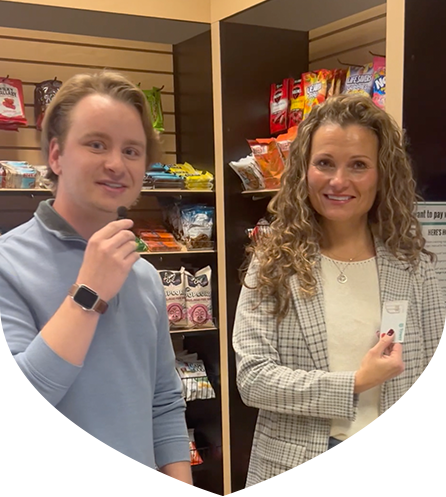Financial Wellness
"Shrinkflation" Takes a Bite Out Of Your Shopping Dollar
The cost of groceries and other goods have increased. But you may not have noticed it, as many everyday products have the same price as before. Don't be fooled—clever packaging shifts might have you getting less product.
It's a tactic called "shrinkflation." It's a boon for sellers, but unpopular for consumers. As Steve Reed, an economist at the Bureau of Labor Statistics (BLS) explains, shrinkflation is a strategy used by consumer product brands and grocery stores "implicitly increasing the price of an item by slightly decreasing the amount or quantity in a package."
Reed said the BLS doesn't have any evidence on why this happens and cannot speak to the motivation or strategies of the sellers, but "the conventional wisdom is that the reason this is done is that it is less noticeable to consumer than sort of an explicit price increase."
Besides changing quantities, another deceptive trick is reduction in the size of the product sold for the same price. Smaller crackers or cookies in a box. Or narrower toilet paper squares.
Another tactic is a change in ingredients that puff up the product with cheaper contents. Again, this results in manufacturers paying less to produce an item while the consumer pays the same price or more.
Less bang for your buck
Check out this list revealing how companies hide rising costs by shrinking the size of everyday home products.
Folgers coffee cans recently decreased from 51 ounces to 43.5. Folgers claims there's a valid reason for this: it now uses lightweight beans. Source: Forbes
The Laughing Cow's spreadable cheese still contains eight wedges in a pack. Problem is, the wedges now weigh 0.675 ounces, down from the previous 0.75 ounces—a 10% reduction. Source: The Krazy Coupon Lady
Chicken of the Sea, StarKist, and Bumble Bee are being accused of inflating the volume of water in tuna cans, unofficially termed "waterflation." Source: Tasting Table
Over the last few years, Frito-Lay shrunk the size of regular bags of Doritos from 11 ounces of chips to 9.25 ounces. That's 22 chips you'll be missing out on. Source: The Krazy Coupon Lady
The Sharing Size of M&Ms candies dropped from 10.7 oz. to 10 oz. That's about 22 fewer candies. Source: The Krazy Coupon Lady
Cadbury recently shrank the size of its multipack chocolate bars while keeping individual bars the same. Cadbury executives claim that the change is part of an effort to fight obesity, rather than inflation. Source: Tasting Table
Arm & Hammer OxiClean liquid detergent bottles have shrunken in weight, across various lines of the product, with up to a 26% reduction. The bottles claim to be "more concentrated." So if you're careful with how you dispense your detergent, perhaps the difference isn't as significant. Source: Reddit
Kirkland Signature Paper Towels rolls used to contain 160 sheets and now hold only 140 per roll. Source: Reddit
Dixie 8.5-inch paper plates went from 285 per pack to 240 recently, keeping the same price. Source: Reddit.
Charmin toilet paper originally had 264 sheets, but it's now down to 242. So you lost 22 sheets on a roll. But in a 12-roll pack, that's the equivalent of getting only 11 rolls. Source: WJLA
Peet's Coffee shrank the packaging size of its Whole Bean Dark Roast French Roast from 12 ounces to 10.5 ounces. Source: WJLA
Suave Shampoo shrank from 30 ounces a bottle to 22.5 ounces. Source: WJLA
Shrinkflation-busting tips
Wondering how to stretch your weekly household shopping budget as far as possible? Here's how to fight back.
Check Product Labels. Consumers, even those already price-conscious, need to focus on comparing products using unit pricing. Otherwise, it may be difficult to recognize which product offers the best value.
According to wikiHow, ''The unit price is the cost per quantity of the item you're receiving. The quantity might be per item or per unit of measurement, such as ounces, grams, gallons, or liters. To calculate the unit price, simply divide the cost of the product by the quantity you're receiving or check the store's shelf label. Then, compare the unit prices of 2 or more packages of the same product to see which offers the better value."
Shop online. Even if you're good at basic arithmetic and quick number crunching, it can take quite a bit of your time while you're navigating store aisles. You might feel less pressured and find it easier to shop online when you can compare prices without feeling rushed.
Don't be a brand slave. If the products you are used to buying aren't giving you the value for your dollar they used to, consider switching to a competitor's brand or the store brand.
Look for sales. Train yourself to hold out for sales before making a purchase.
Bulk up. There are certain things you can buy in bulk to try and offset rising costs, especially for packaged items that are often the most prone to shrinkflation, like snacks, toilet paper, cereal, and cleaning supplies. Just make sure it makes sense for you and your family's needs and that you use it up before it expires.
Impact on consumers
Due to the economy, costs are increasing and we're seeing more companies are participating.
One of the most frustrating things about shrinkflation is the ways retailers intentionally camouflage what's going on. It's not done in an obvious way. The package may look nearly identical, and unless you look at the net weight, you're not going to know there's been a change.
New York consulting firm Clarify Capital's recent study about the practice showed a lack of transparency by businesses:
- More than one-in-10 (12%) surveyed business owners (12%) have used shrinkflation as a strategy. Of those, more than one-third (36%) were not transparent with their customers about it.
- Surveyed business owners' most common reasons for shrinkflation are to stay profitable (64%), to offset rising production and supply chain costs (44%) and to keep their business operational (32%).
- One-in-five surveyed business owners who have not used shrinkflation say they will.
While the practice is not against the law, it definitely angers consumers that end up feeling duped. The lesson? Pay close attention to what you're buying to avoid being misled.


